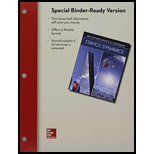
Concept explainers
The 2-lb ball at A is suspended by an inextensible cord and given an initial horizontal velocity of v0. If l = 2 ft, xB = 0.3 ft, and yB = 0.4 ft, determine the initial velocity v0 so that the ball will enter the basket. (Hint: Use a computer to solve the resulting set of equations.)
Fig. P13.201
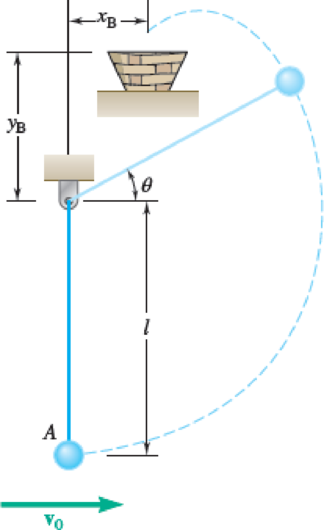
Find the initial velocity
Answer to Problem 13.201RP
The initial velocity
Explanation of Solution
Given information:
The weight of the ball (m) is
The length of the cord (l) is
The horizontal distance between the basket and point of suspension of the ball
The vertical distance between basket and point of suspension of the ball
The acceleration due to gravity (g) is
Calculation:
Show the diagram of the suspended ball by an inextensible cord as in Figure (1).
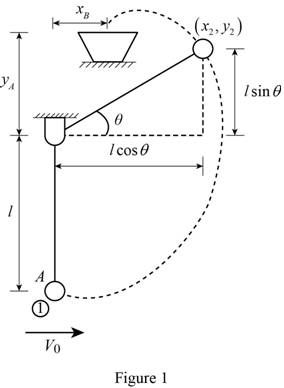
Assume that position ‘1’ be at A and position ‘2’ be at the point described by the angle where the path of the ball changes from circular to parabolic.
The tension in the cord at position ‘2’, becomes slack
Refer Figure (1),
The expression for the x-coordinate of the ball at position ‘2’
The expression for the y-coordinate of the ball at position ‘2’
Show the free body diagram of the ball at position ‘2’ as in Figure (2).
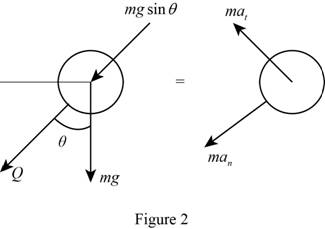
The expression for the normal acceleration of the ball
Since, the cord becomes slack at position ‘2’, so the tension (Q) will be zero.
Calculate the velocity of the ball by applying Newton’s second law and resolve the forces acting on the ball at position ‘2’ using the relation:
Substitute
Substitute 0 for
The expression for the kinetic energy of the ball at position ‘1’
Calculate the potential energy of the ball at position ‘1’
Here, negative sign is used as the ball is located below the datum level and h is the vertical distance of the ball from the datum level.
Substitute
The expression for the kinetic energy of the ball at position ‘2’
The expression for the vertical distance of the ball by referring the Figure 1 as follows:
Calculate the potential energy of the ball at position ‘2’
Substitute
The expression for principle of conservation of energy at position ‘1’ and position ‘2’ for the ball, to calculate the angle swept by the ball
Substitute
Find the velocity at position 2:
Substitute
Show the parabolic motion of the ball after it reaches position ‘2’ as in Figure (3).
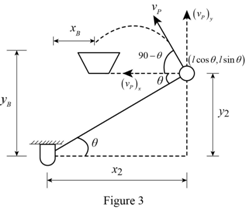
The expression for the velocity of the projectile ball after reaching the position ‘2’
Here,
The expression for the horizontal velocity component of the projectile ball along the negative X-axis as follows:
The expression for the horizontal distance between the basket and point of suspension of the ball
Here,
Substitute
Substitute
The expression for the vertical velocity component of the projectile ball along the negative X-axis as follows:
The expression for the vertical distance between the basket and point of suspension of the ball
Substitute
Substitute
Use trial and error method to calculate the value of
Case (1):
Try
Find the velocity at position 2:
Substitute
Find the time difference between basket and ball:
Substitute
Find the vertical distance between basket and ball:
Substitute
Case (2):
Try
Find the velocity at position 2:
Substitute
Find the time difference between basket and ball:
Substitute
Find the vertical distance between basket and ball:
Substitute
Case (3):
Try
Find the velocity at position 2:
Substitute
Find the time difference between basket and ball:
Substitute
Find the vertical distance between basket and ball:
Substitute
The expression for the data point as follows:
From above calculations, the following set of data points is obtained.
Calculate the general form of quadratic Equation.
Here, a, b, c are constants.
Substitute 0 for
Substitute
Substitute
Solve the equation (7) and equation (8).
Substitute
Substitute
Solve the above equation.
Calculate the angle
Substitute
Find the velocity at position 2:
Substitute
Find the initial velocity
Substitute
Therefore, the initial velocity
Want to see more full solutions like this?
Chapter 13 Solutions
VECTOR MECH...,STAT.+DYNA.(LL)-W/ACCESS
- The beam is made of elastic perfectly plastic material. Determine the shape factor for the cross section of the beam (Figure Q3). [Take σy = 250 MPa, yNA = 110.94 mm, I = 78.08 x 106 mm²] y 25 mm 75 mm I 25 mm 200 mm 25 mm 125 Figure Q3arrow_forwardA beam of the cross section shown in Figure Q3 is made of a steel that is assumed to be elastic- perfectectly plastic material with E = 200 GPa and σy = 240 MPa. Determine: i. The shape factor of the cross section ii. The bending moment at which the plastic zones at the top and bottom of the bar are 30 mm thick. 15 mm 30 mm 15 mm 30 mm 30 mm 30 mmarrow_forwardA torque of magnitude T = 12 kNm is applied to the end of a tank containing compressed air under a pressure of 8 MPa (Figure Q1). The tank has a 180 mm inner diameter and a 12 mm wall thickness. As a result of several tensile tests, it has been found that tensile yeild strength is σy = 250 MPa for thr grade of steel used. Determine the factor of safety with respect to yeild, using: (a) The maximum shearing stress theory (b) The maximum distortion energy theory T Figure Q1arrow_forward
- An external pressure of 12 MPa is applied to a closed-end thick cylinder of internal diameter 150 mm and external diameter 300 mm. If the maximum hoop stress on the inner surface of the cylinder is limited to 30 MPa: (a) What maximum internal pressure can be applied to the cylinder? (b) Sketch the variation of hoop and radial stresses across the cylinder wall. (c) What will be the change in the outside diameter when the above pressure is applied? [Take E = 207 GPa and v = 0.29]arrow_forwardso A 4 I need a detailed drawing with explanation し i need drawing in solution motion is as follows; 1- Dwell 45°. Plot the displacement diagram for a cam with flat follower of width 14 mm. The required 2- Rising 60 mm in 90° with Simple Harmonic Motion. 3- Dwell 90°. 4- Falling 60 mm for 90° with Simple Harmonic Motion. 5- Dwell 45°. cam is 50 mm. Then design the cam profile to give the above displacement diagram if the minimum circle diameter of the か ---2-125 750 x2.01 98Parrow_forwardFigure below shows a link mechanism in which the link OA rotates uniformly in an anticlockwise direction at 10 rad/s. the lengths of the various links are OA=75 mm, OB-150 mm, BC=150 mm, CD-300 mm. Determine for the position shown, the sliding velocity of D. A 45 B Space Diagram o NTS (Not-to-Scale) C Darrow_forward
- I need a detailed drawing with explanation so Solle 4 يكا Pax Pu + 96** motion is as follows; 1- Dwell 45°. Plot the displacement diagram for a cam with flat follower of width 14 mm. The required 2- Rising 60 mm in 90° with Simple Harmonic Motion. 3- Dwell 90°. 4- Falling 60 mm for 90° with Simple Harmonic Motion. 5- Dwell 45°. cam is 50 mm. Then design the cam profile to give the above displacement diagram if the minimum circle diameter of the 55 ---20125 750 X 2.01 1989arrow_forwardAshaft fitted with a flywheel rotates at 300 rpm. and drives a machine. The torque required to drive the machine varies in a cyclic manner over a period of 2 revolutions. The torque drops from 20,000 Nm to 10,000 Nm uniformly during 90 degrees and remains constant for the following 180 degrees. It then rises uniformly to 35,000 Nm during the next 225 degrees and after that it drops to 20,000 in a uniform manner for 225 degrees, the cycle being repeated thereafter. Determine the power required to drive the machine and percentage fluctuation in speed, if the driving torque applied to the shaft is constant and the mass of the flywheel is 12 tonnes with radius of gyration of 500 mm. What is the maximum angular acceleration of the flywheel. 35,000 TNM 20,000 10,000 0 90 270 495 Crank angle 8 degrees 720arrow_forwardchanism shown in figure below, the crank OA rotates at 60 RPM counterclockwise. The velocity diagram is also drawn to scale (take dimensions from space diagram). Knowing that QCD is rigid plate, determine: a. Linear acceleration of slider at B, b. Angular acceleration of the links AC, plate CQD, and BD. D Space Diagram Scale 1:10 A ES a o,p,g b Velocity Diagram Scale 50 mm/(m/s) darrow_forward
- A thick closed cylinder, 100 mm inner diameter and 200 mm outer diameter is subjected to an internal pressure of 230 MPa and outer pressure of 70 MPa. Modulus of elasticity, E=200 GPa. and Poisson's ratio is 0.3, determine: i) The maximum hoop stress ii) The maximum shear stress iii) The new dimension of the outer diameter due to these inner and outer pressures.arrow_forwardA ә レ shaft fitted with a flywheel rotates at 300 rpm. and drives a machine. The torque required to drive the machine varies in a cyclic manner over a period of 2 revolutions. The torque drops from 20,000 Nm to 10,000 Nm uniformly during 90 degrees and remains constant for the following 180 degrees. It then rises uniformly to 35,000 Nm during the next 225 degrees and after that it drops to 20,000 in a uniform manner for 225 degrees, the cycle being repeated thereafter. Determine the power required to drive the machine and percentage fluctuation in speed, if the driving torque applied to the shaft is constant and the mass of the flywheel is 12 tonnes with radius of gyration of 500 mm. What is the maximum angular acceleration of the flywheel. 35,000 TNm 20,000 10,000 495 Crank angle 8 degrees 270 0 90 か ---20125 750 X 2.01 44 720 sarrow_forwardThe gas tank is made from A-36 steel (σy = 250 MPa) and has an inner diameter of 3.50 m. If the tank is designed to withstand a pressure of 1.2 MPa, determine the required minimum wall thickness to the nearest millimeter using (a) The maximum-shear-stress theory (b) Maximum distortion- energy theory. Apply a factor of safety of 1.5 against yielding.arrow_forward
 Elements Of ElectromagneticsMechanical EngineeringISBN:9780190698614Author:Sadiku, Matthew N. O.Publisher:Oxford University Press
Elements Of ElectromagneticsMechanical EngineeringISBN:9780190698614Author:Sadiku, Matthew N. O.Publisher:Oxford University Press Mechanics of Materials (10th Edition)Mechanical EngineeringISBN:9780134319650Author:Russell C. HibbelerPublisher:PEARSON
Mechanics of Materials (10th Edition)Mechanical EngineeringISBN:9780134319650Author:Russell C. HibbelerPublisher:PEARSON Thermodynamics: An Engineering ApproachMechanical EngineeringISBN:9781259822674Author:Yunus A. Cengel Dr., Michael A. BolesPublisher:McGraw-Hill Education
Thermodynamics: An Engineering ApproachMechanical EngineeringISBN:9781259822674Author:Yunus A. Cengel Dr., Michael A. BolesPublisher:McGraw-Hill Education Control Systems EngineeringMechanical EngineeringISBN:9781118170519Author:Norman S. NisePublisher:WILEY
Control Systems EngineeringMechanical EngineeringISBN:9781118170519Author:Norman S. NisePublisher:WILEY Mechanics of Materials (MindTap Course List)Mechanical EngineeringISBN:9781337093347Author:Barry J. Goodno, James M. GerePublisher:Cengage Learning
Mechanics of Materials (MindTap Course List)Mechanical EngineeringISBN:9781337093347Author:Barry J. Goodno, James M. GerePublisher:Cengage Learning Engineering Mechanics: StaticsMechanical EngineeringISBN:9781118807330Author:James L. Meriam, L. G. Kraige, J. N. BoltonPublisher:WILEY
Engineering Mechanics: StaticsMechanical EngineeringISBN:9781118807330Author:James L. Meriam, L. G. Kraige, J. N. BoltonPublisher:WILEY





